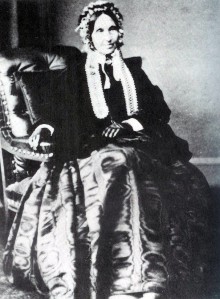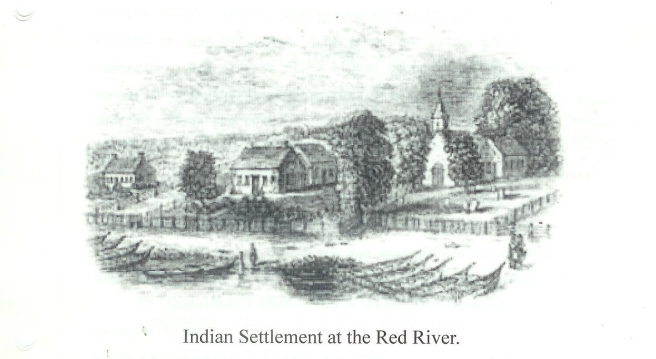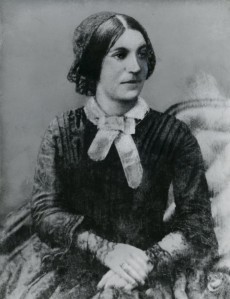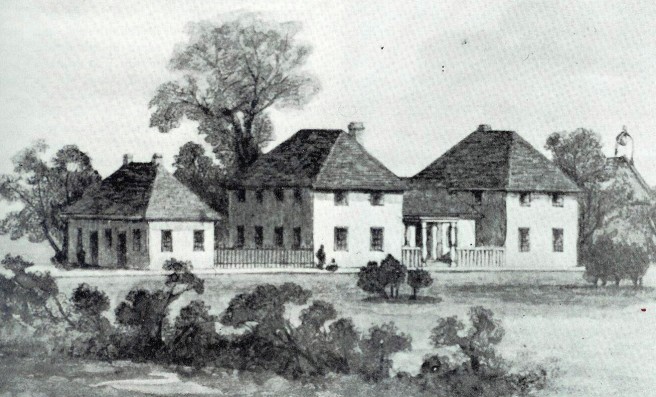Tags: Red River Academy; Red River Settlement education; education of girls; Hudson’s Bay Company and education; Church Missionary Society; Manitoba Education; Reverend David Jones and Mary Lloyd Jones; John MacCallum; Jane McKenzie; Mary Lowman
The Red River Academy
At the end of my last Blog I said that this week I would describe the formation of the Red River Academy, the first high school at the Red River Settlement. Anglican clergyman Reverend David Jones wrote to Hudson’s Bay Company Governor George Simpson outlining plans for a “respectable seminary…for the moral improvement, religious instruction, and general education of boys, the sons of gentlemen belonging to the fur trade.” Simpson approved and suggested educating the girls as well. He also agreed that the HBC could pay the salary of an assistant while the Church Missionary Society agreed to provide a tutor and a governess. As a result, the Red River Academy was founded.
Jones argued that the school would inculcate British values in the children of mixed parentage and–shockingly—the boarding school would separate children from their non-English parents “and thus prevent them from sliding back into barbarism.” [Guest article, pp. 107-9]
Jones asked the CMS to find a governess for the girls who would attend the Red River Academy. He said that she “should be upwards of thirty, of matured Christian experience.” Simpson added that she should be qualified in both ornamental and useful branches of education and preferably not interested in marriage.
In the fall of 1833 John MacCallum and Mary Lowman arrived to take charge of the Red River Academy. Simpson described Mrs. Lowman as “a clever unsurpassed woman.” There were 40 children enrolled initially. Though Mrs. Lowman was highly regarded by Governor Simpson, she did not meet his final criteria, leaving her teaching post two years later to marry retired HBC Chief Factor James Bird.

Mary Lowman
Man. Prov. Archives
Thomas Simpson (Governor Simpson’s cousin) wrote about the new school to Donald Ross, HBC factor at Norway House.
When all the young ladies don their new leg-horns, [a style of straw hat that was fashionable at the time] they cut a dash that would captivate a whole troop of dragoons. Their improvement in manner and appearance is really amazing. I cannot speak too highly of that seminary and the recent acquisitions. Mrs. Lowman and Mr. MacCallum seem admirably qualified to teach the twenty lads and twenty lasses. The establishment will accelerate the progress of morality throughout Rupert’s Land.” [Shave article p. 7]
Ross and his wife Mary sent some of their numerous children to the Red River Academy. They were very anxious that their daughters should marry well and obviously believed that education would assist to that end. Their two oldest daughters Jane (Jean) and Jessie both graduated from the Red River Academy and then were sent to England to complete their education at a “finishing” school. Donald Ross described Jane’s two and a half years in London. He said that the principal reason for sending her to school there was for her to learn to play the piano, but evidently she had little musical ability. Not only did she not learn the piano, she also unsuccessfully tried to learn to play the guitar and to sing.
Despite her lack of musical ability, Jane made what her parents considered a good marriage. She wed an Anglican missionary named James Hunter less than a year after the death of his first wife. Mrs. Ross, rather defensively remarked, “People would wonder at the haste, but we were not going to let such a good catch slip.” [Quoted in Gordon book, p. 71] Hunter was beginning to translate religious literature into Cree when he married Jane. Jane, who had lived all her life at Norway House, was fluent in Cree and played a major role in doing these translations—some of which are still in use.
Jane’s younger sister Jessie also made what appeared to be a good marriage to an employee of the HBC, but tragically she became serious ill of tuberculosis and died within a year of the wedding.
John MacCallum
A graduate of King’s College in Aberdeen, John MacCallum became head master of the Red River Academy. Feelings about him were mixed. He was a scholarly man, and some parents approved of the high standards he set for the school. Others believed he was too strict with his students and his punishments too severe.
Despite the auspicious beginnings for the Academy, some white parents objected to their children being taught with Indian children. After the daughter of an HBC officer became pregnant by an Aboriginal boy who worked in the school kitchen, Simpson ordered that the school for First Nations children be moved to Grand Rapids.
After Mrs. Lowman left to marry in 1835, MacCallum taught the girls as well as the boys. Some parents were pleased that he taught their daughters something other than sewing and cooking. In addition to the Ross daughters, another female graduate of the Academy who did well was Jane McKenzie. She was daughter of Roderick McKenzie, a Scottish fur trader, and a Nipigon woman named Angelique. Jane taught at the Academy beginning in 1846 when she was 21. It is not known how long she taught there, but she did not marry until 1854. Two of her sons would become a lawyer and a doctor respectively.
Harriet Sinclair (born in 1832) began attending the Red River Academy when she was 14, the same year as Jane McKenzie began teaching there. As an elderly woman in the early 1920s, she told an interviewer about her life. She said that she was sent as little girl to a boarding school begun by a woman named Mrs. Ingham who had arrived from England in 1833 as a companion to Mrs. Lowman. Mrs. Lowman became Harriet’s step-grandmother when she married James Bird who was Harriet’s grandfather. Harriet completed her education at a college in Illinois which she attended for two years (1848-1850). In 1852 Harriet married a doctor named William Cowan, who had come from England [Healy, pp. 17-28]
Harriet Cowan (née Sinclair)
Man. Prov. Archives
In October 1836, Mrs. Jones died in child birth, leaving her husband Reverend Jones with five young children. When he returned to England in 1838, the HBC purchased the school for ₤500. They arranged a five-year lease with MacCallum, who was to remain in charge, maintain the buildings in good repair and pay 10% of the purchase price each year as rent. In 1841, he purchased the school outright. When the Anglican bishop visited from Montreal in 1844, he praised the school as well as ordaining MacCallum. The sketch below is from the book the bishop wrote about his trip.

The year after the bishop’s visit, however, problems arose at the school and the number of students dropped sharply. Letitia Hargrave, wife of the HBC factor at York Factory, never visited the Red River; but she took an avid interest in the gossip she learned about the Red River Academy from various correspondents. Some of them wrote about how badly headmaster MacCallum conducted the school. He was accused of punishing children with severe floggings and confinement and by making them miss meals. Children were supposedly fainting due to the missed meals. MacCallum made the girls exchange their Indian leggings for English footwear. They had to go out walking every day in winter and without proper footwear, their feet got wet and they got ill.

Letitia Hargrave
Also MacCallum did not allow mothers who were not legally married to visit their children. Letitia was very critical of this policy. As she said, “it is fearfully cruel… [because] the poor unfortunate mothers did not know that there was any distinction and it is only within the last few years that any one was so married.”
MacCallum finally quarreled with the governess Miss Allen, who had come from England to teach at the Academy in 1840. MacCallum blamed her because the school was falling on hard times. He said she was “careless and lazy, had extraordinary peculiarities of manner which made her the laugh of her school girls and was not sufficiently accomplished to carry on the education of young ladies”. Miss Allen, in turn, said MacCallum was so despotic and overbearing that the children were terrified of him and their parents were taking them out of school as a result. MacCallum fired Miss Allen in 1845. [Gordon, pp. 120-21]

Red River Academy sketch by Peter Jacobs while he was a student at the Academy
Metropolitan Toronto Library Board
MacCallum died in October 1849, at the same time that Bishop David Anderson arrived as the first Anglican Bishop of Rupert’s Land. MacCallum left the school to the bishop in his will. Soon afterwards Bishop Anderson renamed the school St. John’s Collegiate School.
My next Blog on June 14 will describe the development of French language education at the Red River.
Notes:
Gordon, Irene Ternier. Letitia Hargrave: Mistress of York Factory
Healy, W.J. Women of the Red River, Winnipeg: Canadian Women’s Club, 1923
Shave, Harry, “Pioneer Protestant Ministers at Red River” (1), Manitoba Historical
Society Transactions, 1949-50
Print copies of all my books and an e-book (e-pub version) of Letitia Hargrave: Mistress of York Factory may be purchased through my website at http/www.ireneterniergordon.ca or by e-mailing me at author@ireneterniergordon.ca
Most of my books are also available as Kindle e-books from Amazon.


